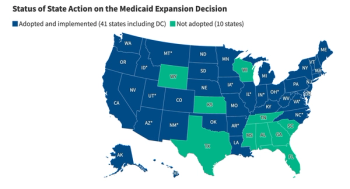
For New Drugs, Manufacturers are Becoming Payers: 2022 Asembia Specialty Pharmacy Summit
IQVIA’s Lucas Greenwalt says manufacturers need to provide patient assistance if they want their new brands to meet sales goals as payers devise strategies to cope with cost and the increasing number of ultra-expensive medications skyrockets.
Patient assistance programs are not just the occasional coupon but a centerpiece of the marketing strategy for brand-name medications that are new on the market, according to Lucas Greenwalt, vice president and lead of IQVIA’s Market Access Center of Excellence.
And that market has become increasingly intricate and multifacted as manufacturers and payers navigate the market dynamics of price and cost, Greenwalt said during a presentation Monday at the 2022 Asembia Specialty Pharmacy Summit: “The amount of the complexity in the industry is at all time high."
As many as 70% of newly launched brands are supported by patient assistance, by manufacturers, Greenwalt told a large audience at his presentation. “We see manufacturers stepping in as the primary payer.”
“It is no longer that we see patient assistance coming in as a secondary strategy as products come into the market,” Greenwalt added later. “It is now the primary strategy for brand success as you are launching a product.”
Payers have responded to copay assistance with accumulator programs that result in the value of the coupon not counting toward the deductible. Greenwalt shared data showing that between 5% and 25% of specialty brands are affected by accumulator programs. For patients, accumulators can mean a “copay surprise” that means a large jump in their out-of-pocket costs. The rate at which patients discontinue their prescriptions is 13 times higher after a copay surprise than it would be otherwise, said Greenwalt.
In Greenwalt’s description, the market for newly launched brand-name drugs are increasingly hemmed in by payer efforts to control costs through prior authorization, formulary placement and other pharmacy management efforts. He said only 1 in 4 patients who are prescribed a new brand-name product are able to successfully fill that prescription the first time they try. One result of this experience and others that result in fewer prescriptions is that many (more than half) of newly launched drugs miss their first-year sales forecasts, he said.
Greenwalt also discussed the growing number of drugs with annual list prices of $200,000. Over the past 20 years, he said approximately 70 drugs were launched in that price range. IQVIA projects that number will double in the next five years.
The problem is not paying for any particular drug; Greenwalt noted that many of these ultra-expensive medications are cures or for conditions with no other treatments. “The question is how we are going to pay for them all?”
Newsletter
Get the latest industry news, event updates, and more from Managed healthcare Executive.





















































